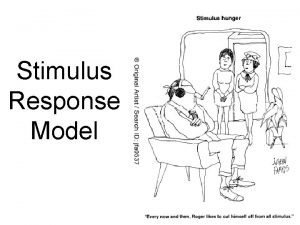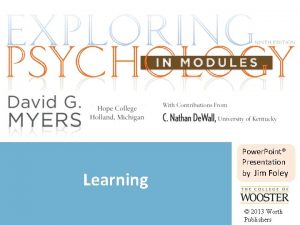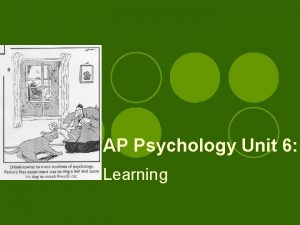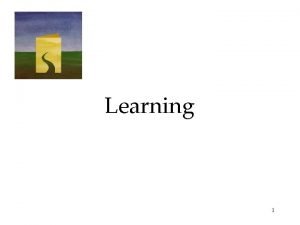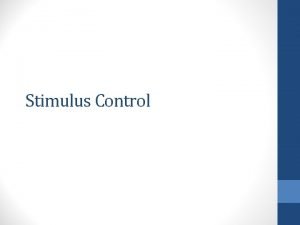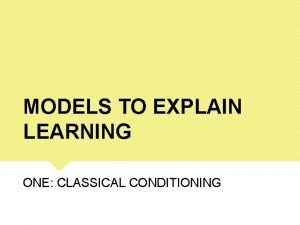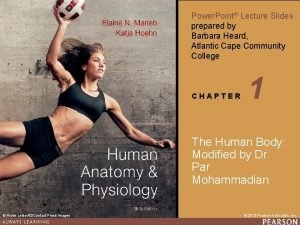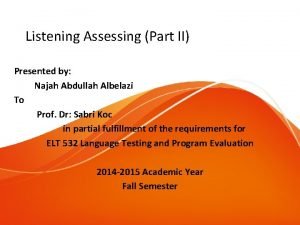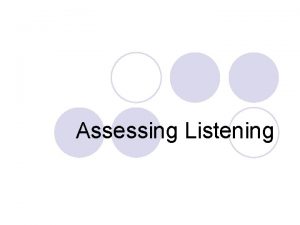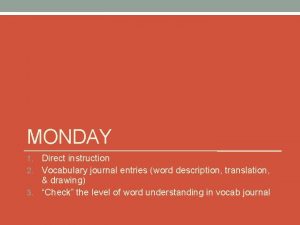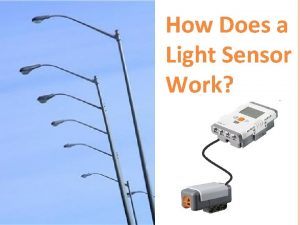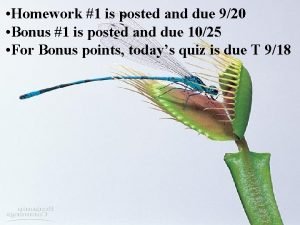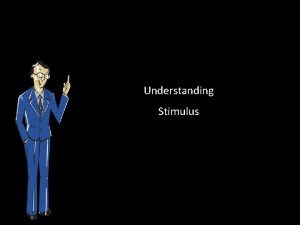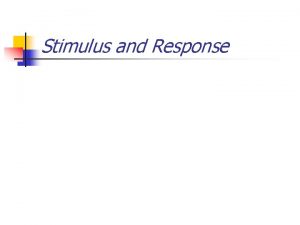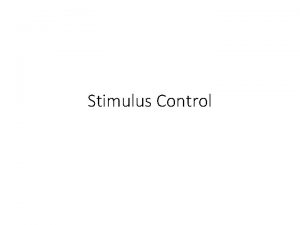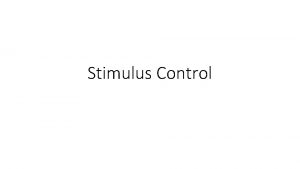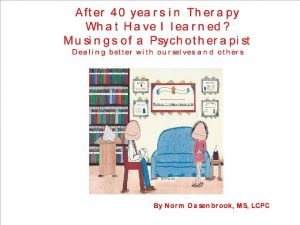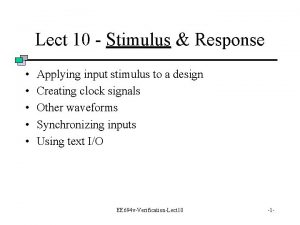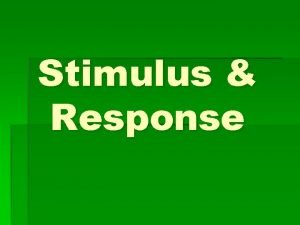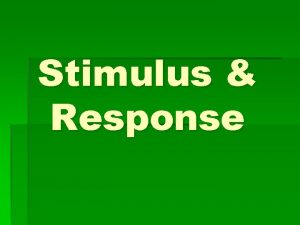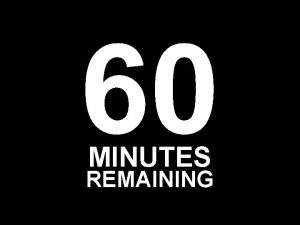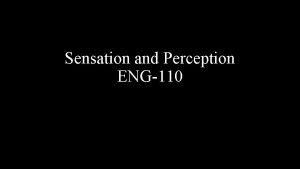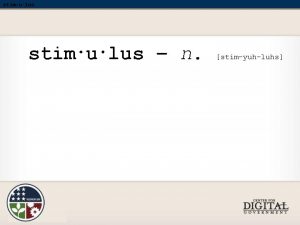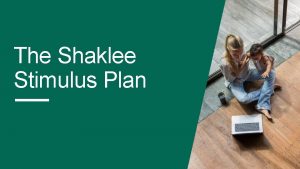Stimulus Response Model Remaining alive requires Detecting and

















- Slides: 17

Stimulus Response Model

Remaining alive requires…… Detecting and responding to Stimuli A stimulus is any change in the internal or external environment INTERNAL STIMULUS EXTERNAL STIMULUS e. g. Decrease in body temperature e. g. seeing a speeding car approaching Increase in level of carbon dioxide Temperature of the external environment Decrease in blood glucose level Texture of ground Increase in amount of salt in the blood Hearing the phone ring Reduction in calcium level of the blood Heat from hot bath

Receptors for External Stimuli Found together in SENSE ORGANS EYES EARS NOSE TONGUE SKIN

EYES: photoreceptors in retina detect light NOSE AND TONGUE: chemoreceptors are sensitive to different chemicals

EARS: sound receptors SKIN: • Thermo receptors (heat/cold) • Pressure/touch receptors • Pain receptors

Model for response to a stimulus • Read the information on the cut and paste sheet and assemble the parts into a model that looks like this……. .

The Stimulus Response Model Stimulus A change in the internal or external environment that can elicit a response Feedback The change in the original stimulus brought about by the response. Receptor Cells or organs that detect a change once threshold is reached To maintain homeostatic the original stimulus must be reversed. This is called NEGATIVE FEEDBACK Response The change brought about by the effector Effector Cells, organs, muscles or glands that respond to a stimulus Transmission of message by… Nerves Or hormones Control Centre Brain or Spinal cord: Receives signals, analyses them and determines the response. Transmission of message by…. Nerves Or hormones

Negative feedback High body temperature INCREASE too high Response makes body temperature DECREASE OPPOSITE DIRECTION TO Keepinginternal statestable Time Low OPPOSITE DIRECTION TO body temperature Response makes body DECREASE too LOW temperature INCREASE The stimulus produces a response in the opposite direction to the original stimulus. This alters the stimulus received by the receptors

Negative feedback High body temperature INCREASE too high Response makes body temperature DECREASE OPPOSITE DIRECTION TO Keeping internal state stable Time Low OPPOSITE DIRECTION TO body temperature Response makes body DECREASE too LOW temperature INCREASE The stimulus produces a response in the opposite direction to the original stimulus. This alters the stimulus received by the receptors

Applying the Stimulus Response Model • Practise applying the model • Choose two the following scenarios to complete scenario 1 and scenario 2 models on your worksheet. • Then try scenario 3, an example with multiple effectors all contributing to the response.

• A torch is aimed at your eyes and shines bright light into them. This light is detected by photoreceptors (light receptors) in the retina at the back of the eye……. . • You have some bad seafood for dinner and start to feel really queasy…next think you are running for the bathroom. . . . • You go to pick up a tripod that was used in your science experiment but it is still red hot……. • You are running around Albert Park lake and your hard working muscle cells are using up lots of energy. This means that carbon dioxide is being produced and its levels are starting to increase in the blood………. • You haven’t eater for a while and your blood glucose levels start to fall…… ……. what happens next…show your chosen scenarios as a stimulus response model.

The Stimulus Response Model Stimulus Receptor Increase in light intensity entering the eye Photoreceptors in the retina Feedback Reduction in the amount of light entering the eye A torch is aimed at your eyes and shines bright light into them. This light is detected by photoreceptors (light receptors) in the retina at the back of the eye……. . Response Effector Iris width adjusted to reduce size of pupil Muscles of the Iris Transmission of message by… Nerves Control Centre brain Transmission of message by…. Nerves

The Stimulus Response Model Stimulus Receptor Noxious chemicals from bacteria ingested with food Chemoreceptors in the wall of the intestine Feedback Harmful chemical removed from stomach You have some bad seafood for dinner and start to feel really queasy…next think you are running for the bathroom. . . . Response Effector Vomiting; ejection of food from the stomach Diaphragm muscle and muscles of the abdomen Transmission of message by… Nerves Control Centre brain Transmission of message by…. Nerves

The Stimulus Response Model Feedback Temperature of skin is reduced Stimulus Receptor very hot temperature on the skin Thermoreceptors in the skin Transmission of message by… Nerves Control Centre You go to pick up a tripod that was used in your science experiment but it is still red hot Response Effector Drop the tripod Muscle in the hand Spinal cord Transmission of message by…. Nerves

The Stimulus Response Model Stimulus Carbon dioxide level of the blood increases Feedback Reduction in level of Carbon dioxide in the blood Receptor Chemo receptors in the aorta and carotid artery You are running around Albert Park lake and your hard working muscle cells are using up lots of energy. This means that carbon dioxide is being produced and its levels are starting to increase in the blood………. Response Effector Increase activity of the intercostal muscles and the diaphragm to Diaphragm muscle and intercostal muscles increase breathing rate Transmission of message by… Nerves Control Centre Brain Transmission of message by…. Nerves

The Stimulus Response Model Stimulus A fall in the level of glucose in the blood Feedback Increase in blood glucose level Receptor Chemo receptors in the pancreas You haven’t eater for a while and your blood glucose levels start to fall Response Effector Convert glycogen into glucose and release into blood Liver cells Transmission of message by… Nerves Control Centre Brain Transmission of message by…. hormones

Receptor Stimulus Core body temp falls Feedback Thermoreceptors in hypothalamus …. . THIS IS NEGATIVE FEEDBACK Control Centre BRAIN Effector Response Skeletal muscles Muscles contract to generate more heat Effector Response Pilo erector muscles Hairs stand on end to trapping warm air Effector Response Arterioles constrict and skin become pale Less blood nears skin surface Transmission of message by_nerves_ Muscles in arteriole wall in the skin Transmission of message by nerves
 Alive alive forevermore
Alive alive forevermore He's alive he's alive frankenstein
He's alive he's alive frankenstein Stimulus and response
Stimulus and response Generalization classical conditioning
Generalization classical conditioning Biofeedback ap psych
Biofeedback ap psych Meaning of relatively permanent
Meaning of relatively permanent Gravitropism and geotropism
Gravitropism and geotropism Discriminatory stimuli
Discriminatory stimuli Response prompt vs stimulus prompt
Response prompt vs stimulus prompt Neutral stimulus
Neutral stimulus Sd and sdelta
Sd and sdelta Discriminative stimulus psychology definition
Discriminative stimulus psychology definition Stimulus receptor signal response
Stimulus receptor signal response Communicative stimulus-response tasks
Communicative stimulus-response tasks Recognizing phonological and morphological elements
Recognizing phonological and morphological elements Response to stimulus
Response to stimulus How does light sensor work
How does light sensor work Stimulus receptor signal response
Stimulus receptor signal response


